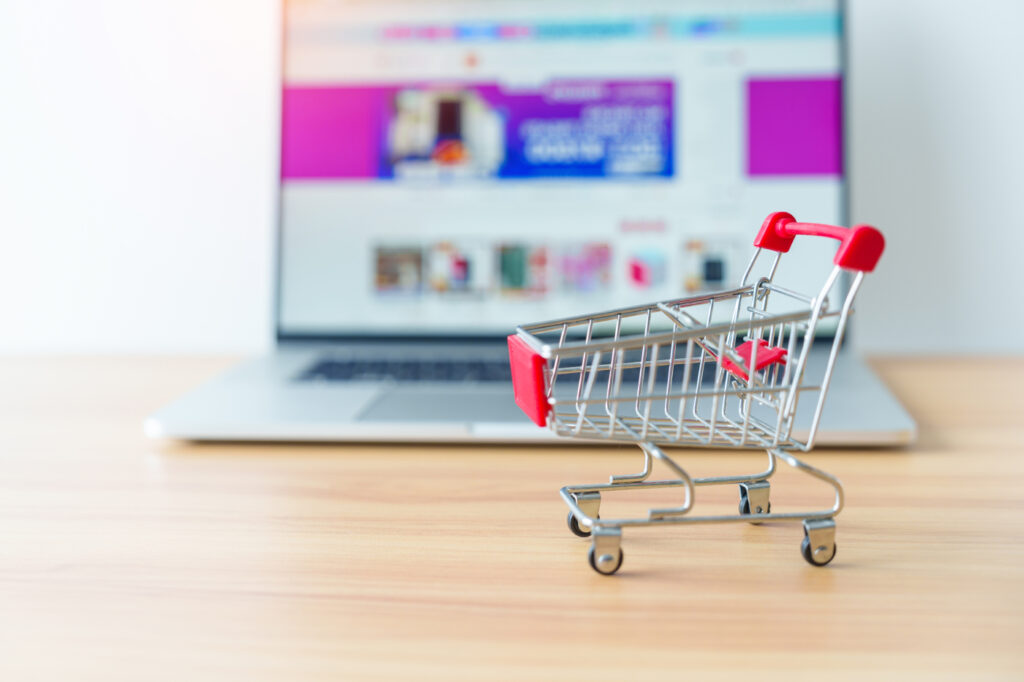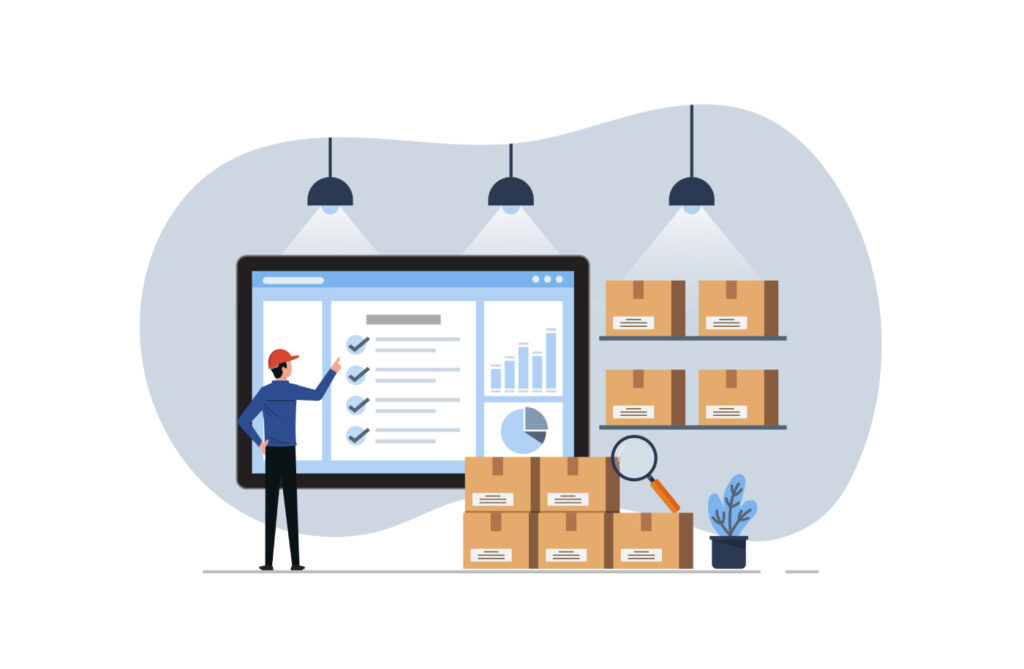This guide explores the best cash registers and POS systems for small businesses, focusing on ease of use, cost, features, and overall value. Whether you need a straightforward cash register or a feature-rich POS system, our curated list will help you find the perfect solution for your business needs.
Based on our evaluation of more than 20 of the top solutions on the market, here is our final list of the six best cash registers for small businesses in 2024:
While traditional Electronic Cash Registers (ECRs) mainly handle basic sales transactions and print receipts, POS systems integrate with other business operations and credit card processing, offering a more comprehensive solution that can significantly enhance efficiency.
Not only that, but in 2024, many of the prominent names in cash registers — like Casio and Sharp — no longer manufacture cash registers, meaning support is very limited. For these reasons, the best cash registers for small businesses are actually POS registers, not ECRs, which is reflected in this guide.
Best Cash Registers Compared
Vendor
Our Rating (Out of 5)
Price
Key Features
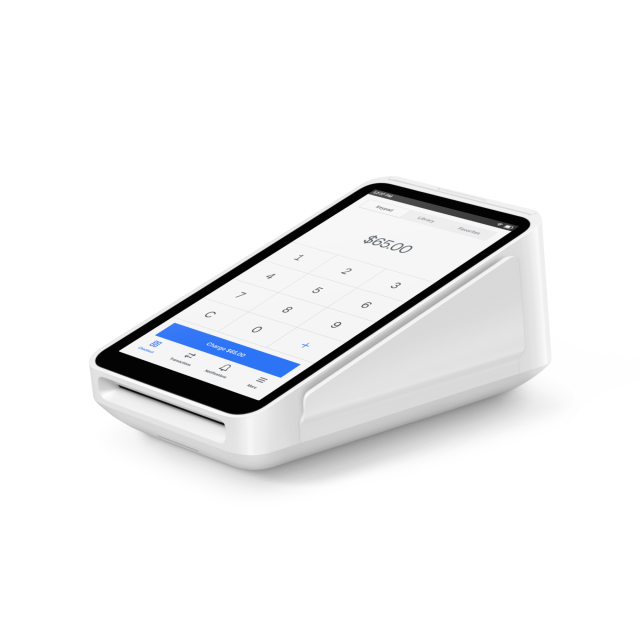
Square Terminal
4.75
$299 or $27/month
- Supports multiple payment types
- Integrates with Square’s apps
- Long battery life
- Basic inventory management

Square Register
4.50
$799 or $39/month
- All-in-one POS system
- Dual display
- Customizable
- Supports Cash App payments
- Integrated accessories
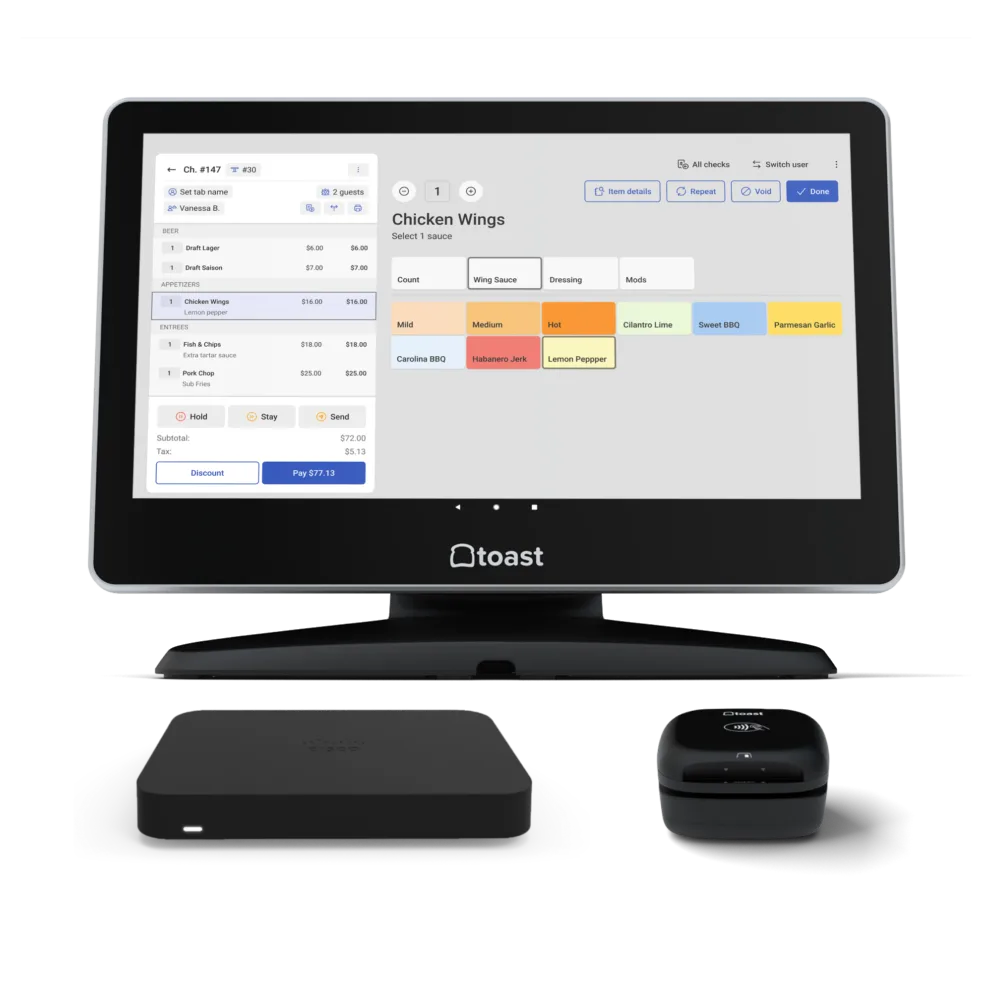
Toast Countertop
4.44
$799 upfront or $69/month
- Versatile ordering options
- Real-time reporting
- Durable hardware
- Customizable menu management
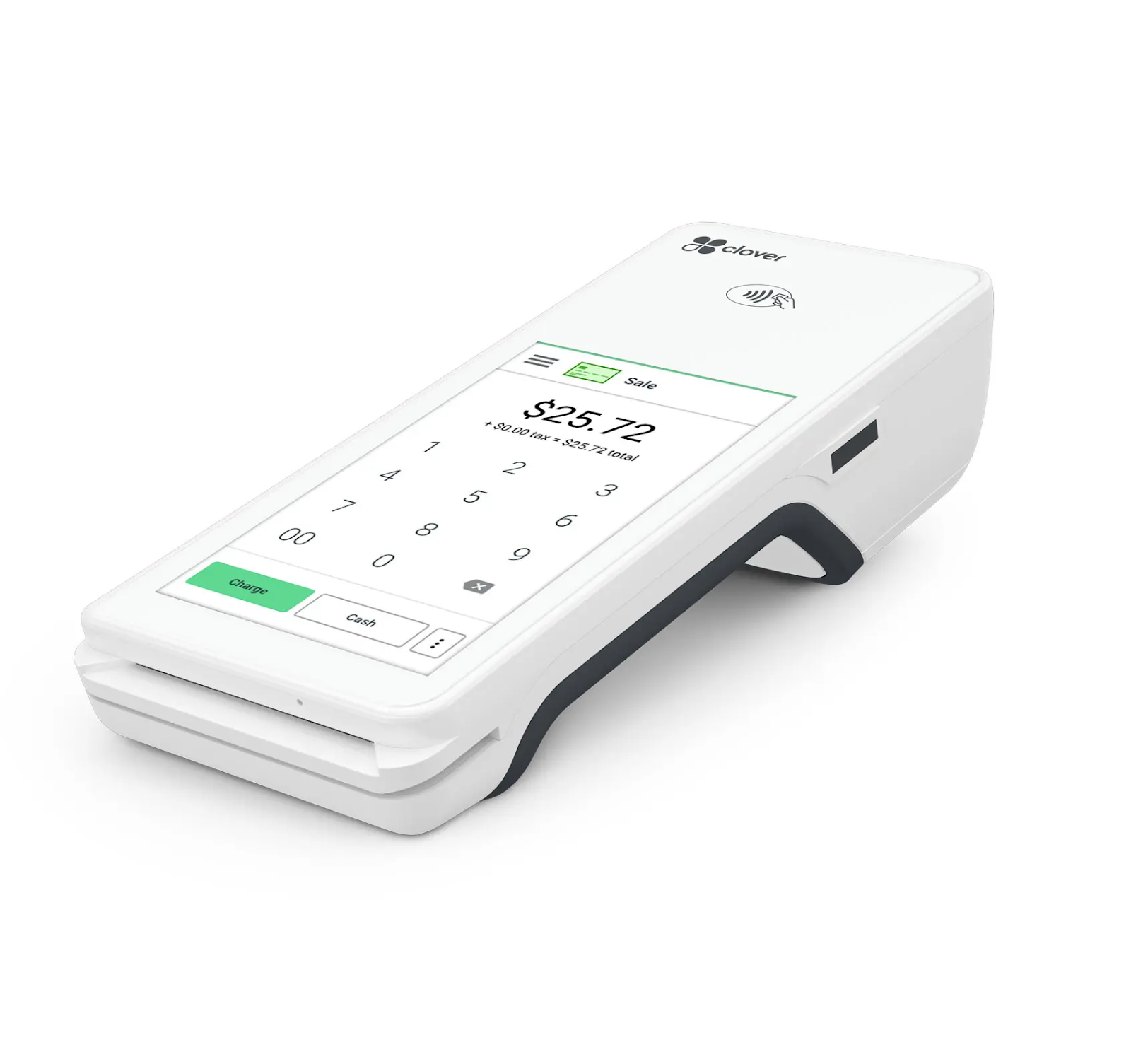
Clover Flex
4.38
$599 upfront or $35/month
- Built-in printer and barcode scanner
- Customizable interface
- Real-time data syncing
- Fingerprint login
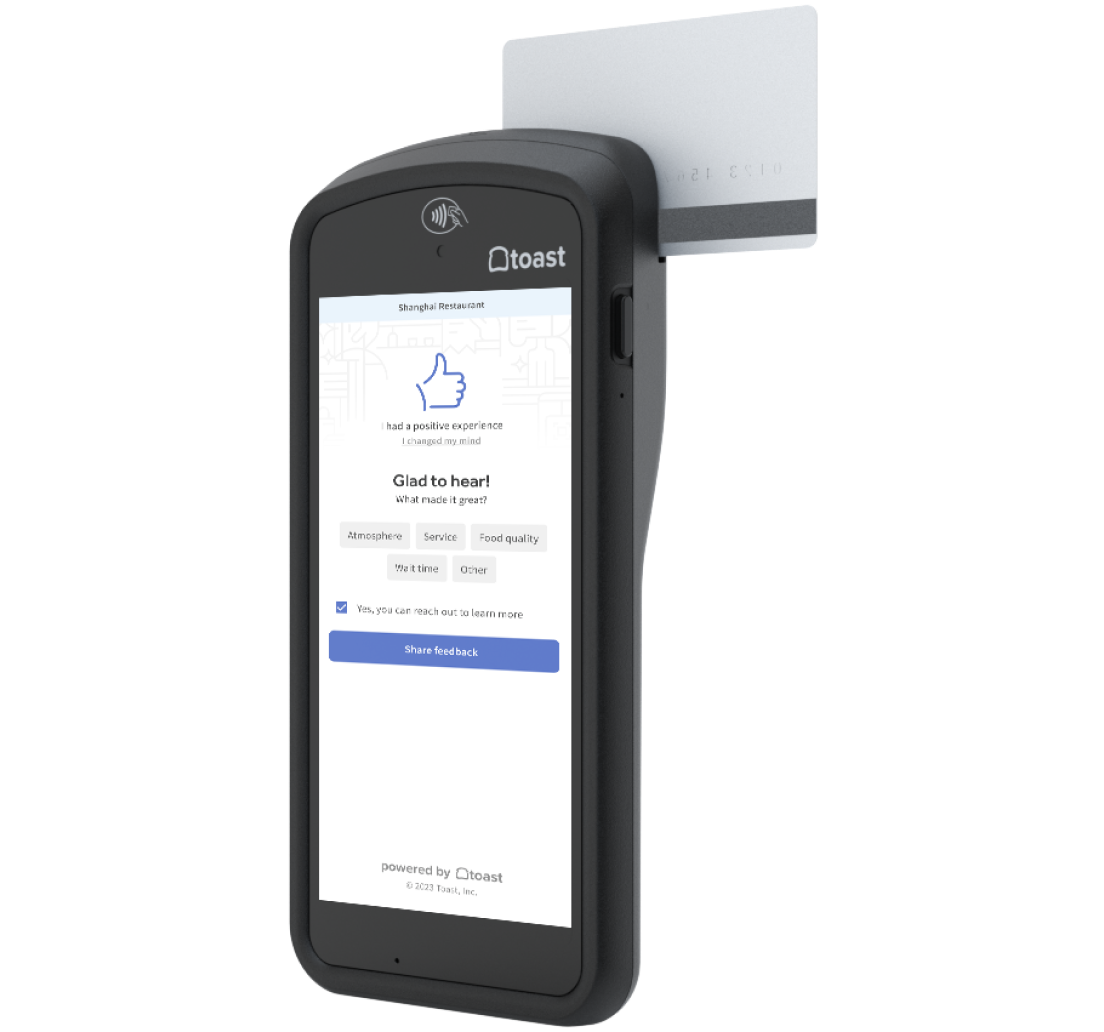
Toast Go 2
4.35
$799 upfront or $0 upfront with higher fees
- Durable design
- Integrated payment processing
- Real-time menu updates
- Comprehensive reporting
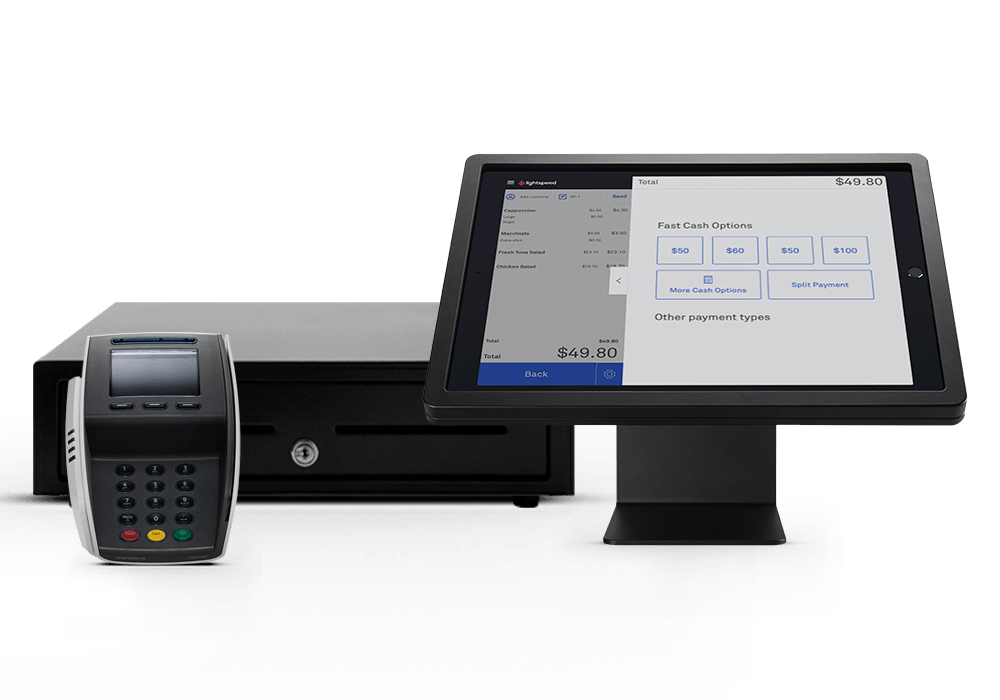
Lightspeed Retail
3.77
$89/month (annually)
- Real-time cross-location inventory
- Multi-location pricing
- Shared customer database
- Customizable workflows
Read more: Best POS Hardware for Business

Square Terminal: Best overall
Overall Score
4.75/5
Pricing
5/5
Hardware
5/5
Functionality
5/5
Support and reliability
3.75/5
UX
5/5
Pros
- Supports multiple payment types
- Integrates with Square’s apps and services
- Long battery life
- Basic inventory management tools
Cons
- Requires internet connection for transactions
- Additional costs for accessories (printers, cash drawers, etc)
Why we chose Square Terminal
Square Terminal is the best cash register for small businesses because it offers an impressive balance of affordability, user-friendliness, and comprehensive features. At $299 with no monthly fees, it is the most competitive option on this list in terms of price.
A breath of fresh air, Square keeps transaction fees simple and competitive. You’ll pay 2.6% + 10¢ per in-person transaction, a straightforward structure that makes it easy to anticipate costs.
A must for modern cash registers, Square Terminal focuses on portability. With a built-in battery, you can process payments anywhere in your store, giving you flexibility that Clover’s more stationary devices can’t match. This mobility can be a game-changer for managing busy periods efficiently in any location.
Though the main focus of this guide is hardware, I’d be remiss to omit Square’s software. Square’s free POS software is packed with valuable features. You’ll benefit from comprehensive inventory management tools, customer engagement options, and real-time analytics. These features often come at an additional cost with other systems like Clover, Lightspeed, and Toast, but they’re included in your Square package.
For small businesses and startups, Square Terminal’s quick setup process and intuitive interface are major advantages. You can have your system up and running quickly, without the need for extensive training.
Also read: Best POS Systems for Small Business

Square Register: Best countertop register
Overall Score
4.5/5
Pricing
3.75/5
Hardware
5/5
Functionality
5/5
Support and reliability
3.75/5
UX
5/5
Pros
- All-in-one POS system
- Flexible pricing with no long-term commitments
- 24/7 customer support via phone and chat
- Dual display
- Highly customizable
Cons
- Higher upfront cost compared to competitors
- Transaction fees add up for higher-volume businesses
Why we chose Square Register
Square Register is a countertop POS solution that offers a powerful combination of comprehensive features.
Launched in 2017, this fully integrated system has become a stalwart in the POS market.
With a dual touchscreen display setup, this innovative design allows both you and your customers to view and confirm transactions, enhancing transparency and reducing errors during checkout.
The hardware itself is designed to enhance your checkout process. The 13.25″ HD seller-facing touchscreen gives you clear visibility and control over transactions. Meanwhile, the 7″ customer-facing display ensures transparency and engagement with your clients during the payment process.
Reliability is a key strength of Square Register. The system’s built-in software updates keep the POS current without any effort on your part. Moreover, the ability to process offline payments for up to 24 hours means your business can keep running smoothly, even during internet outages.
Square Register’s versatility is further enhanced by its seamless integration with Cash App and compatibility with various third-party accessories. This flexibility allows you to customize your setup to meet your specific business needs.

Toast Countertop: Best for Restaurants
Overall Score
4.44/5
Pricing
4.38/5
Hardware
5/5
Functionality
4.06/5
Support and reliability
5/5
UX
3.75/5
Pros
- Versatile ordering options (self-serve kiosks, online ordering pages, etc.)
- Real-time reporting
- IP-rated for protection against steam and dust
- Extensive training materials
- Built-in payment processing supports EMV cards and mobile payments
Cons
- Toast-exclusive payment processing
- Contracts, including automatic renewals and early termination fees
Why we chose Toast Countertop
With its restaurant-specific features like tableside ordering and real-time inventory tracking, Toast has carved out a significant niche in the food service industry. The system’s durable hardware, designed to withstand the rigors of a busy kitchen environment, has been a key selling point for many establishments.
This system is designed to enhance your operational efficiency and elevate the customer experience in ways that general POS systems or ECRs simply can’t match.
One of Toast’s standout features is its versatile ordering options. You’ll have access to self-serve kiosks, a dedicated TakeOut & Delivery app, and integrated online ordering. These tools allow you to streamline your operations, reduce wait times, and cater to your customers’ diverse preferences, whether they’re dining in, taking out, or ordering for delivery.
Durability is crucial in a busy restaurant environment. Toast’s hardware is built to withstand the rigors of high-volume service, ensuring your POS system remains reliable even during your busiest rushes. This robust construction can save you time and money on repairs and replacements in the long run.
Toast’s reporting and analytics capabilities are another major advantage. You’ll have access to detailed, real-time insights into your sales, labor costs, and inventory levels. These tools empower you to make data-driven decisions, optimize your menu, manage your staff more effectively, and control your costs.
Also read: Best Free POS Systems
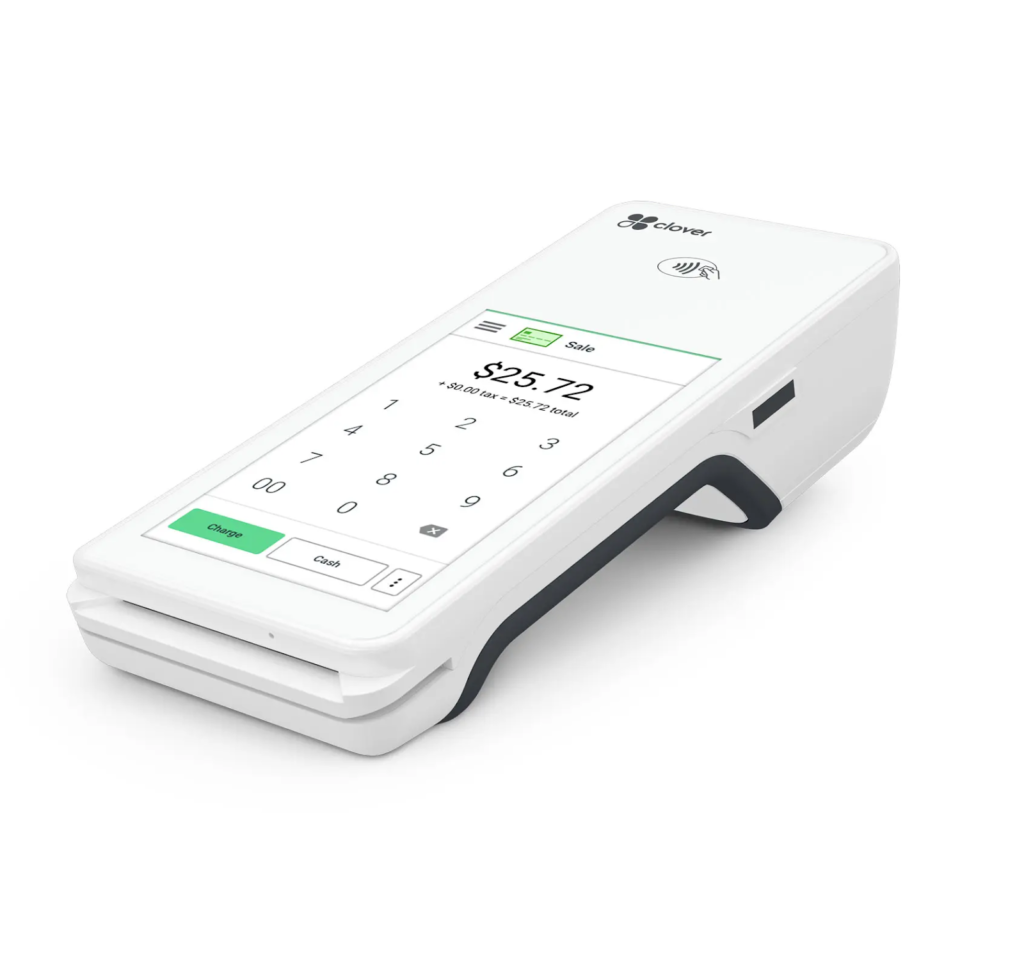
Clover Flex: Best mobile option
Overall Score
4.38/5
Pricing
3.75/5
Hardware
5/5
Functionality
5/5
Support and reliability
3.13/5
UX
5/5
Pros
- Comprehensive Clover app marketplace
- Supports magstripe, chip, and contactless payments
- Easy to navigate and intuitive
- 5.99-inch screen protected by Gorilla Glass
- Transactions and data sync across devices in real-time
- 24/7 customer support
Cons
- 2100 mAh battery may not last a full day
- Users cite ‘dated’ design
Why we chose Clover Flex
For mobile commerce, Clover Flex makes a compelling case by mixing functionality with convenience. The compact device packs a powerful punch, featuring a generous 6-inch touchscreen that serves as a command center for various business operations. Its built-in receipt printer and barcode scanner eliminate the need for additional equipment, a significant selling point for mobile vendors.
The device caters to a wide range of consumer preferences, accepting traditional card payments alongside modern contactless options like Apple Pay and Google Pay, and more recently, CashApp and Venmo. It can accept these newer digital payments using QR code technology.
Users have praised its easy integration with Wi-Fi and LTE networks. This ensures businesses can process transactions securely, regardless of their location. This feature is particularly valuable for mobile setups such as pop-up shops and food trucks, where reliable internet access can be unpredictable.
When compared to alternatives, Clover Flex offers distinct advantages for mobile businesses. Its built-in printing capabilities and superior mobile connectivity make it a more comprehensive solution for on-the-go operations. These features eliminate the need for separate printers and provide a more reliable connection in various environments.
However, potential users should consider a couple of factors. While the device’s 8-hour battery life is sufficient for many businesses, it may pose challenges for those with extended operating hours or who use the POS more than the average vendor.
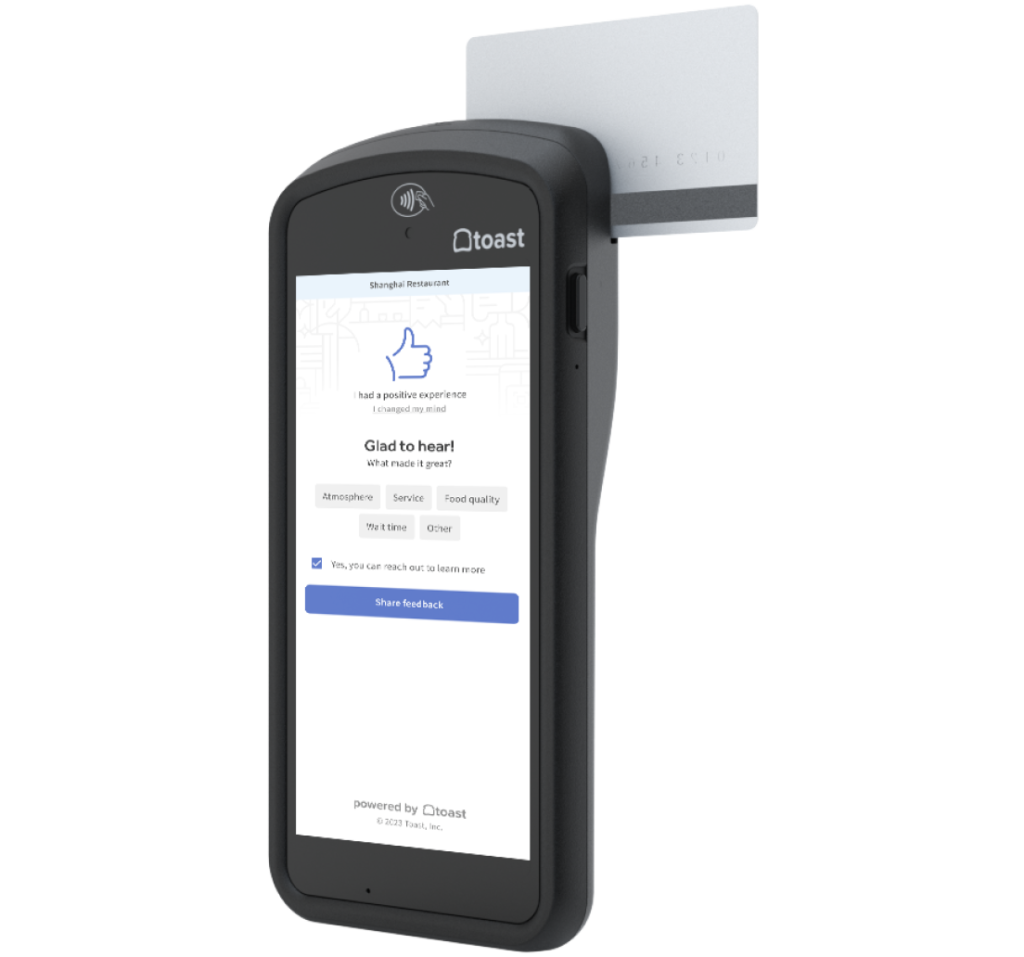
Toast Go 2: Best for tableside service
Overall Score
4.35/5
Pricing
4.4/5
Hardware
4.6/5
Functionality
4.1/5
Support and reliability
5/5
UX
3.8/5
Pros
- 24-hour battery life
- Highly durable – drop-proof and water-resistant
- Support for modern payment systems
- Split checks, add tips, and complete transactions at the table
- Fits in apron or back pocket
Cons
- Add-on costs
- Limited customization
Why we chose Toast Go 2
The handheld version of the Toast POS system, the Toast Go 2 has carved out a niche as the “go-to” solution for restaurants seeking to elevate their tableside ordering experience.
With the Toast Go 2, you can manage the entire front-of-house experience from a single device. By allowing staff to take orders and process payments directly at the table, it significantly streamlines operations, reducing the back-and-forth between tables and fixed POS terminals.
Similar to other Toast hardware, Toast Go 2 has a rugged, spill-proof design that ensures the device can withstand the rigors of daily use, from accidental drops to liquid spills. Coupled with a long-lasting battery, it’s built to endure even the busiest shifts without interruption.
With an impressive 24-hour battery life, the Toast Go 2 can operate throughout an entire day in busy restaurant environments without requiring a recharge. This extended battery life contrasts with the Square Terminal’s 14-hour capacity, which may necessitate recharging during long shifts or high-volume periods.
The Toast Go 2 also represents a significant advancement over its predecessor, the original Toast Go. It handles transactions up to three times faster than the original Toast Go, significantly reducing customer wait times and enhancing efficiency during peak hours.
Moreover, the Toast Go 2 has kept up with evolving payment methods, supporting modern methods, including NFC and digital wallets. This versatility ensures that restaurants can cater to a wide range of customer payment habits.

Lightspeed Retail POS with iPad Hardware Kit: Best for multi-location retail
Overall Score
3.77/5
Pricing
1.88/5
Hardware
4.17/5
Functionality
4.38/5
Support and reliability
3.75/5
UX
4.70/5
Pros
- Strong inventory management
- Excels in managing multiple locations
- Various integrations
- Front-end and back-end tools are intuitive and easy to use
- Built-in e-commerce capabilities
- Over 40 customizable reports
Cons
- Online transaction fees higher than many competitors
- Expensive software fees
Why we chose Lightspeed Retail
Lightspeed Retail POS, paired with its iPad hardware kit, is particularly strong at managing complex operations across numerous stores, offering a level of integration that’s crucial for growing retail enterprises.
At the heart of Lightspeed’s appeal is its top-notch multi-location inventory management. The system provides real-time visibility into stock levels across all locations. In other words, Lightspeed’s inventory management tools are far superior to what’s typically found in an ECR.
When compared to POS alternatives like Square, Lightspeed still offers more comprehensive inventory management features. Its detailed location comparison reporting provides deep insights into store performance, allowing management to make data-driven decisions about resource allocation and strategy.
In addition to tracking inventory across locations, Lightspeed allows you to create customized pricing strategies across your different stores to cater to local market conditions. Lightspeed’s CRM features and loyalty tools are also accessible across locations and channels.
Additionally, customizable workflows allow businesses to maintain operational consistency across locations while adapting to local needs.
In terms of the hardware itself, Lightspeed’s iPad hardware kit offers a user-friendly interface that’s easy for staff to master. This familiarity can lead to quicker adoption and reduced training time, which is particularly beneficial for businesses with high staff turnover.
However, potential users should consider that the higher cost might be a barrier for smaller businesses or those just starting out. Additionally, the system’s complexity, while beneficial for larger operations, might be overwhelming for single-location stores with simpler needs.
POS vs. Cash Register: What is the difference?
| Electronic Cash Register | Point-of-Sale System | |
|---|---|---|
| Primary Functionality | Basic sales recording and cash handling | Comprehensive business management (sales, inventory, CRM) |
| Payment Processing | Cash and basic card processing | Cash, credit/debit cards, digital wallets (Apple Pay, Google Pay) |
| Inventory Management | Limited to none | Real-time inventory tracking |
| Sales Reporting | Basic, often manual | Detailed, automated sales reports |
| Customer Data | Limited to none | Customer relationship management (CRM) capabilities |
| Scalability | Limited, suited for small, single-location businesses | Highly scalable, suitable for multi-location businesses |
| Cloud-based? | No | Yes |
| Support and Updates | Often discontinued or limited | Ongoing support and regular updates |
| Initial Cost | Generally lower upfront costs | Higher upfront or subscription-based |
| Long-term Value | Limited functionality, potentially higher long-term costs | Greater functionality, better long-term value |
| Ease of Use | Simple setup and use | Easy to moderate setup. Higher learning curve |
| Integration and Compatibility | Minimal | High, integrates with accounting, marketing, eCommerce |
The choice between a traditional cash register and a modern Point of Sale (POS) system can significantly impact a business’s operations and future growth. While cash registers have long been a staple for small businesses due to their simplicity and affordability, technological advancements have made POS systems increasingly accessible and cost-effective, often providing superior overall value.
What’s a Cash Register?
Cash registers are basic machines designed primarily for recording sales and handling cash transactions. They typically include a cash drawer, a receipt printer, and basic sales recording capabilities. Their simplicity makes them easy to set up and use, but this comes at the cost of limited functionality. Moreover, as technology advances, many cash register manufacturers have discontinued or reduced support for these products, making it increasingly difficult to find new models or receive ongoing support.
What’s a POS System?
In contrast, POS systems offer a more comprehensive solution for managing business operations. These systems integrate hardware and software to provide a versatile platform for managing sales, inventory, and customer data. Modern POS systems can process various payment types, including credit cards and digital wallets, manage inventory in real-time, generate detailed sales reports, and even facilitate customer loyalty programs.
Also read: What Are the Different Types of POS Systems?
Why POS Systems are a Better Choice
One key advantage of POS systems is their cloud-based nature. This feature allows business owners to access their data from anywhere, ensuring automatic backups and reducing the risk of data loss.
Additionally, POS systems are highly scalable, making them suitable for businesses anticipating growth. For instance, systems like Lightspeed Retail POS offer extensive multi-location management capabilities, real-time inventory tracking, and customizable pricing strategies across different store locations.
Contrary to common perception, many modern POS systems are now more affordable and easier to set up than traditional cash registers. For example, Square’s plan starts at $0 per month, offering full inventory and customer management features that a standard cash register cannot provide. The flexibility and support offered by POS providers often outweigh the initial cost difference, making them a more practical choice for many new businesses.
While traditional cash registers may seem like a cost-effective solution for new businesses, POS systems offer far greater functionality and long-term value. As cash register manufacturers phase out their products, POS systems provide a more sustainable, efficient, and scalable solution for managing sales and operations. For new businesses, investing in a POS system could streamline operations and enhance growth potential from the outset.
Finding the right cash register for your business
When choosing a cash register solution for your business, it’s crucial to focus on key factors that will directly impact your operations and long-term success.
Pricing should be transparent and competitive, offering good value for the features provided while considering both upfront costs and ongoing fees to understand the total cost of ownership.
Hardware durability and compatibility are essential — your equipment must be able to withstand daily use and integrate seamlessly with other systems.
By carefully evaluating these and other aspects outlined in this article, you’ll be better positioned to select a cash register solution that not only meets your current needs but also supports your business as it grows. The right system should streamline your operations, enhance customer service, and provide valuable insights into your business performance. Take the time to assess your specific requirements and compare different options, as this investment in decision-making will pay off in improved efficiency, better customer experiences, and a more manageable workload for your team.
Also read: Best Restaurant POS Systems for 2024




